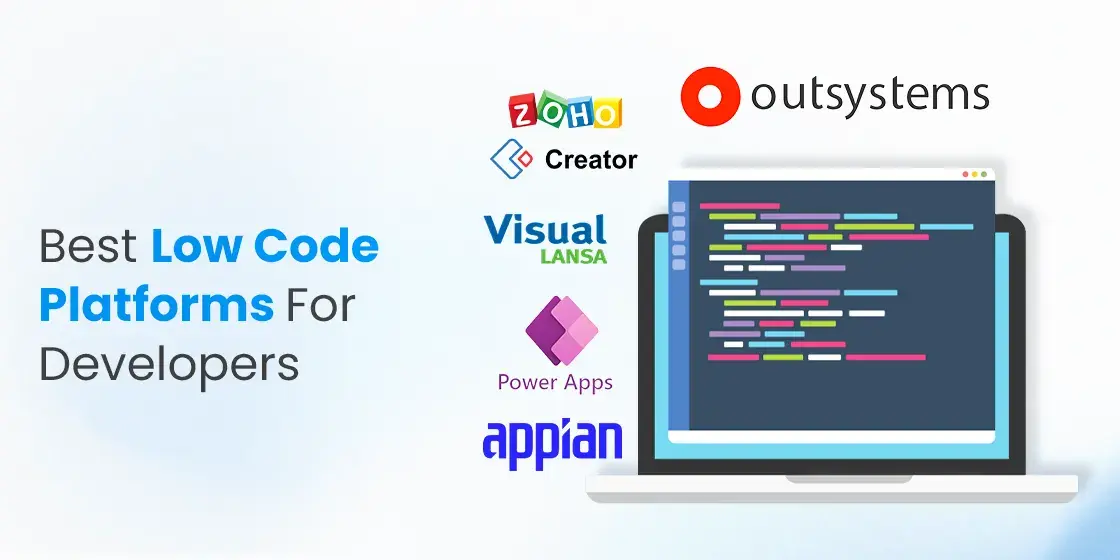Integration of low-code applications offers a variety of advantages, such as the ability to seamlessly integrate multiple applications and systems. Here are a few main benefits: pre-built connectors and APIs.
Wide Range of Connectors: Low-code platforms typically have a large library of pre-built connectors to popular enterprise systems (e.g. ERP, CRM databases, cloud services, etc.). This simplifies the process of connecting these systems.
API Integration: A lot of Low-Code platforms have out-of-box API integration capabilities, which allow developers to effortlessly connect external services as well as data resources.
Easy of use:
Drag-and–Drop Interfaces: Many integration tasks can easily be completed using drag-and–drop interfaces. This allows for developers and other non-developers to develop complex systems with out lengthy programming.
Visual Workflow Builders: Tools to create workflows and data flows that are visually represented help to learn and configure integrations in a much more simple manner.
Standardized Integration Methods:
SOAP and restful services that support web services standard protocols such as REST and SOAP makes integration easy with an array of platforms and systems.
OData, Other Standards: The support for standards such as OData helps to access and manipulation data across applications and platforms.
Real-Time Data Synchronization:
Real-Time Integrations: Low-code platforms allow real-time data synchronization between apps and systems, making sure that data is always up-to-date and consistent throughout the company.
Event-Driven Architecture: Certain platforms have support for event-driven architectures, permitting applications to respond to events in real time, which is essential for interactive and dynamic applications.
Legacy System Integration:
Low-code platforms: These can be used to connect older systems to the latest. They're a great way to upgrade your IT infrastructure without having to redesign everything.
Data Migration Tools Data Migration Tools: Data migration tools built-in facilitate the transfer of data from older systems to the latest applications developed on low-code platforms.
Integration of Third-Party Services:
Integration with Cloud Services: Seamless integration with cloud-based services like AWS, Azure, and Google Cloud allows for the ease of deployment and scaling applications.
Business Applications Integration: Low-code platforms can integrate with different business applications like Salesforce, SAP, Microsoft Dynamics and more. to create a seamless workflow that spans different business processes.
Simplified Data Management:
Unified Data Models: Some low-code platforms have unification of data models that simplifies data management and integrating between various systems.
Data connectors: Preconfigured data connectors allow easy access and modification to data from multiple sources.
Security and Compliance
Secure Integrations: Low-code systems ensure that integrations adhere to security protocols and standards, assisting to protect data during transit and at rest.
Compliance Features: These platforms typically contain features that ensure integrations comply with the requirements of regulatory agencies (e.g., GDPR, HIPAA), providing security for companies dealing with sensitive data.
Extensibility:
Custom Codes and scripts. For more complex needs in integration, low-code platforms often allows the inclusion custom scripts and code. This gives flexibility but without compromising user convenience.
Plug-in Ecosystem: An ecosystem of plugins and extensions can enhance the integration capabilities that allow users to include new functionalities as needed.
Overall, the integration capabilities of low-code development platforms make them an excellent device for building connected, efficient and scalable applications. They simplify the process of linking disparate systems. They enhance the flow of information, and allow enterprises to use existing technology while embracing new ones, which results in a cohesive and integrated IT environment. Take a look at the recommended right here for website info including push notifications, cross platform mobile dev, develop web application, application modernisation, rapid action development, cross platform mobile development, jdbc server, low code platforms, driver jdbc, mobile development platforms and more.

Benefits Of Low-Code Application Development In Terms Of Scalability, And Flexibility
Low-code applications have a number of advantages in terms of scalability. They are flexible and able to be adapted to new requirements. Here are the key benefits: Rapid Scaling:
Cloud-based Deployment : Many low-code platforms are built. This allows applications to grow seamlessly in tandem with cloud infrastructure. This enables businesses to manage more workloads without having to worry about the management of servers.
Auto-Scaling: This feature allows you to automatically adjust resources in accordance with the demands. This will ensure the same performance even during peak hours and without manual intervention.
Flexible Architecture:
Modular Design: Low-code systems encourage modular design of applications, in which components can be developed independently, tested, and scaled. Modularity improves the flexibility of an application and makes it simpler to update or expand specific components of a program without affecting the entire system.
Microservices Integrate: They allow applications to grow and become flexible by allowing them to be constructed as a group of services that are loosely connected.
Customizable Options:
Extensibility: Low-code platforms generally allow for customized scripting and programming, which allows developers to expand the functionality of applications beyond the ones that are available. This allows the fulfilment of specific business requirements without restrictions.
Third-Party Integrations: The incorporation of third-party APIs, services or other services enables businesses to increase the capabilities of their application by adding additional functionalities.
Agile Development and deployment:
Continuous Delivery and deployment: Low-code platforms work with agile methodologies and enable continuous integration and delivery (CI/CD). This allows for the rapid deployment and update of features.
Iterative Design: Because low-code is an iterative process, applications can be incrementally enhanced and scaled up. This allows for gradual growth and decreases the risk of massive changes.
Resource Optimization
Resource management that is efficient Low-code platforms maximize resources by providing tools to monitor and control application performance. This makes sure that resources are used efficiently and are easily scaled to meet actual needs.
Load Balancing : The integrated load balancing feature divides the workload evenly among servers. This increases the application's ability to handle large volumes of traffic and also ensures constant performance.
Global Reach
Multi-Region Deployment: Low-code systems typically support deployment across several geographic regions, enabling businesses to provide low-latency services to users across the globe. This is particularly important when it comes to applications that have an international user base.
Support for Localization. Built-in support to localize applications allows them to be easily adapted to different local languages, regional needs and increases their flexibility across diverse markets.
Updates and maintenance
Simplified maintenance: The graphic and modular nature of low-code software makes it easy to perform the maintenance tasks. They allow updates and bug fixes to be made quickly without a long period of downtime.
Version Control: Integrated version control software helps control changes and roll backs. This makes sure that updates can easily be implemented and earlier versions can be restored if needed.
Cost Efficiency:
Low Development Costs. By reducing coding requirements, low-code platforms reduce the cost of development and allow applications to scale up without requiring more development effort.
Pay-As You-Go Models: Many low-code platforms offer flexible pricing models, like pay-as-you go, which aligns costs with actual usage and growth, allowing the flexibility to finance.
The ability to scale low-code applications lets businesses develop strong and flexible, scalable and robust applications. These platforms offer quick and efficient responses to changes in requirements, resource efficiency, and continuous improvements, allowing the application to expand with a business. Read the recommended Enterprise application development with Low-code Platform for more recommendations including cross platform mobile app development, application modernization software, cross platform app dev, database in azure, application modernisation, jdbc server, stored sql procedures, develop mobile application, develop cross platform mobile app, application development platforms and more.

Benefits Of Low-Code App Development With Respect To Limitations And Customization
Low-code development offers an approach that is balanced to address limitations, while also allowing for customization. Here are a few of the main benefits.
Resolving Complexity:
Low-code development platforms are easier to use due to the fact that they come with ready-made components, templates, as well as other tools. They also allow for rapid deployment of even the most complicated applications.
Many platforms feature guided workflows, which assist developers navigate through complicated procedures. They reduce the chance of making mistakes and help maintain the consistency.
Scalability Solutions
Scalability Built-In: Lowcode platforms usually include capabilities to support scalable architecture. They permit applications to handle growing loads without major changes.
Performance Monitoring Tools: tools for monitoring and optimizing performance are built into the application to ensure it remains efficient regardless of how it expands.
Security and compliance:
Integrated security features: Low-code platforms include security measures like encryption and access control based on role and automated compliance monitoring that address security issues.
Platforms are regularly updating their security protocols and methods of conformity, which assures that applications are safe from new threats.
Capabilities for Customization:
Extensibility:
Low-code platforms can often be able to integrate custom code, such as JavaScript or Python, allowing developers to extend their functionality beyond the limitations of normal.
Custom Plugins and Modules Developers are able to create custom modules or plugins to add specific functionalities tailored to specific business needs.
APIs and Integration:
API Support: Full API support is available to facilitate seamless integration and communication to external systems.
Third-Party Services: Low-code platforms often offer pre-built connectors for popular third-party services, which makes it easier to connect and modify applications.
Flexible Design for UI/UX:
Customizable user interfaces for developers: Developers can modify and design the user interfaces to meet specific branding requirements and usability needs, providing the user with a customized experience.
Responsive Design: Built-in responsive design capabilities mean that apps can be tailored to fit different sizes of screens and devices.
Business Logic Customization
Visual Workflow Builders Visual tools for designing and customizing workflows and business logic let developers create complex, tailored workflows without coding.
Platforms can provide conditional logic to adapt to specific business rules or scenarios.
Data Management:
Custom Data Models: Developers are able to develop custom data models that meet specific requirements of an application and ensure that data handling is customized to the business needs.
Advanced Data Processing: The integration with advanced tools and capabilities for data processing permits customization of how data is analyzed and utilized within the application.
How do you balance personalisation and limitations:
Frameworks and Standards
Best Practices for Compliance Low-code platforms promote the use of industry-leading practices and standards. This helps in maintaining high-quality, flexible, and secure apps.
Governance Frameworks. Inbuilt frameworks for governance guarantee that modifications will not compromise the security, integrity, or compliance of the application.
Iterative Design and Feedback
Rapid prototyping: Developers are able to quickly prototype and test customizations in response to feedback from users, and improve the app based on their needs.
Continuous Improvement: Platforms with low-code support for continuous improvement, allowing customization and enhancement when the requirements of business change.
Users Empowerment
Low-code platforms empower citizen developers through letting non-developers with intuitive interfaces, to personalize applications, they increase the number of contributors who can enhance and tailor apps.
Support and Training Resources: Many platforms provide an extensive set of training and support resources that allow users to modify applications without compromising their stability or performance.
Low-code applications offer a flexible framework that can be tailored to meet your specific requirements. This balance enables businesses to develop and maintain applications that are efficient, adapted to their particular requirements and adhere to high standards of security, quality, and scalability.
